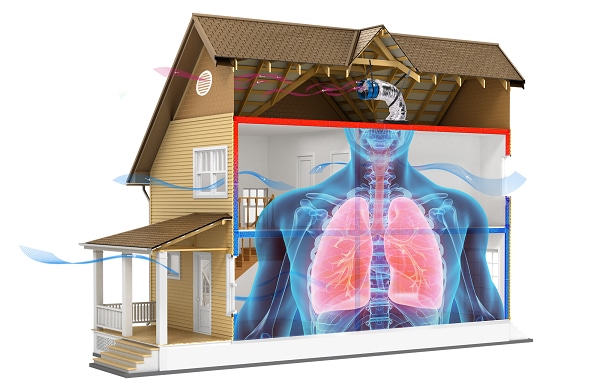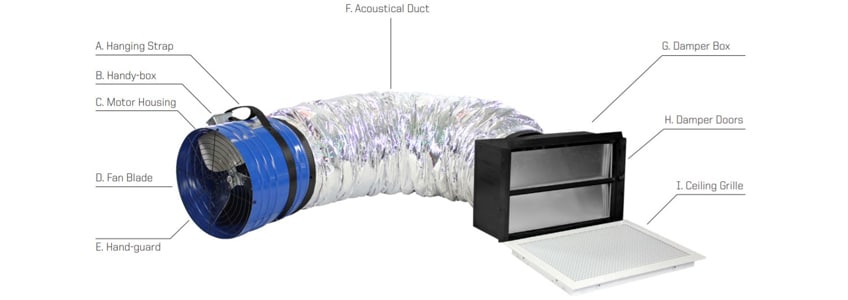
What is a Whole House Fan?
What is a Whole House Fan?
Do you enjoy the feeling of fresh, cool air flowing through an open window? A whole-house fan, also known as an attic fan, is a cooling device that can help you experience that feeling any time while saving you money on air conditioning costs and improving indoor air quality.

How Does a Whole House Fan Work?
A whole-house fan works by exhausting warm, stale air out of your home (through the attic) and pulling in fresh, cool air from open windows. It is very similar to an attic fan, except a whole-house fan is installed in the ceiling, rather than in the attic, and simply moves air out the attic through ductwork. As its name implies, a whole-house fan can help cool your entire house thanks to its central location, whereas an attic fan removes heat from only the attic.
When using a whole-house fan, you need to keep some windows open for the fresh air to enter your home. As the fan sucks the warm indoor air out the attic, it makes room for cool, outdoor air to rush into the home below. This creates an invigorating breeze that has the following benefits:
Keeps You Comfortably Cool
At the end of a hot day, your home can feel very sticky and gross. Oftentimes, especially during spring and autumn, the outside temperature feels cooler. A whole-house fan brings this naturally cool air inside. If your fan is in a central hallway, it can effectively distribute the cool air around your home. Otherwise, for the ultimate comfort, you can install a fan in each bedroom to keep everyone comfortably cool all night.
Saves Energy
Certain whole-house fans can save an estimated 50-90% off traditional cooling methods such as air conditioning. While these fans work best in dryer climates, the U.S. Department of Energy reports that a whole-house fan can be a good substitute for an air conditioner for most of the year.
Improves Indoor Air Quality
How often does your home stink after dinner? The stench of cooking oils and smoke can linger for hours into the evening. By refreshing the air, a whole-house fan removes these odors, gases, and other indoor pollutants. Not only do you feel cooler, but you can breathe cleaner air.
How to Use a Whole House Fan
A whole house fan is best used when the outdoor temperature is 5-10 degrees cooler than the indoor temperature. You don’t want to use a whole-house fan when the outdoor temperature is warmer because then you wouldn’t be cooling down your home (although you could still enjoy a nice breeze effect and exhaust indoor air pollutants).
For this reason, the best time to use a whole-house fan is in the early morning or in the evening when it’s cooler outside. Some people like to leave the fan on overnight to help them sleep. Although traditionally very noisy, quiet whole-house fans are available today that won’t interrupt your slumber.
When your fan is on, you can keep your air conditioner off and save on cooling costs. For example, when you wake up, open your windows and turn on the whole-house fan to cool your home down for the day. Then, when you go to work, the A/C doesn’t need to be on anyway. When you return in the evening, you can turn the fan on once again to cool your house off. Just remember to close your windows and turn off the fan before leaving the house for the day!
As mentioned, whole-house fans work best in dry climates. If the outdoor air is humid, you’d be bringing that humidity inside the home. For this reason, it’s rare that a whole-house fan would be effective in humid climates.
Sizing a Whole-House Fan
It's important to size a whole-house fan properly to ensure it generates enough airflow to cool your house. You also don't want it so large that it'll create an air vacuum at home.
We recommend having a professional do a sizing to determine the necessary CFM (cubic feet of air per minute). If you're looking for a quick and dirty method, though, you can multiply your home's square footage by the average ceiling height. Then, multiply that number by 30 and, finally, divide by 120.
[(Square Footage * Ceiling Height) * 30] / 120 = CFM
For example, suppose your home is 2,000 square feet and you have 8-foot ceilings. Multiplying those numbers (8 x 2,000) gives you 16,000 sq ft.
Then, multiply 16,000 by 30 to get 480,000. Finally, divide 480,000 by 120 to get 4,000 CFM of airflow. When shopping for whole-house fans you would find one that can handle at least the amount you just calculated.
Whole-House Fan Installation
We recommend having a professional install your whole-house fan, especially if you’re uncomfortable doing it yourself. The general steps to install a whole-house fan are as follows:
- Choose the installation location in your attic above a central hallway.
- Use the cardboard cutout template that comes with your fan to trace your cut.
- Cut the hole in your ceiling using a drywall saw.
- Secure the motor housing, damper box, and duct in the hole you cut.
- Have a professional electrician do any necessary wiring for your fan.
Whole-house fan installation will vary depending on the product and manufacturer. Always consult your owner’s manual for specific installation instructions.

When installing, it’s also important to consider venting. When the fan sucks all the air into your attic, it needs some way to get outside. We recommend having one square foot of net free venting per 680 CFM. That means, for every 680 CFM your unit puts out, you should have one square foot of open venting available. For example, if you have a 4,000 CFM unit, make sure you have at least 5.9 square feet of venting (4,000/680=5.9).
It is also very important to properly insulate the gaps and spaces around your fan and cover it during winter when not in use. Otherwise, you’ll be losing heat out the attic.
A Cleaner Way to Cool
Although it won't replace your air conditioner entirely, a whole-house fan will let you use it only when necessary, so it's not running nonstop. Also, instead of that artificial cold air, you'll feel the freshness of a natural breeze.
If you have additional questions about whole-house fans, we're here to help. Give us a call at (866) 631-6389.




